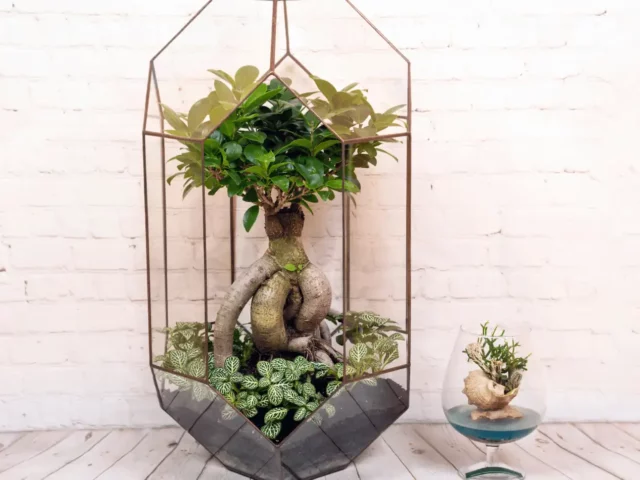You might not realize that the timing for removing bonsai wires is as critical as the technique itself, often dictated by the tree’s subtle signals rather than a fixed calendar date.
If you’ve wrapped your bonsai in wire to shape its growth, knowing when to liberate it from these metallic constraints is key to preventing damage and scars.
Factors like the species’ growth rate, the season, and even the thickness of the bark play pivotal roles in this decision.
Let’s explore how to interpret these signs and make an informed choice, ensuring your bonsai remains healthy and aesthetically pleasing. This understanding could dramatically change how you approach the care of your miniature trees.

Key Takeaways
- Remove wire before spring budding to prevent branch constriction and ensure healthy growth.
- Regularly check for wire cutting into branches, especially during active growth periods.
- Winter is the ideal time for wire removal, preparing the bonsai for spring.
- Use precise tools and techniques for wire removal to avoid damaging the bonsai.
Recognizing Signs of Stress
Spotting signs of stress early on can save your bonsai from permanent damage, as wire left too long often digs into the growing branches, leaving undesirable marks. You’ve got to keep an eagle eye out for wire biting into the bark or leaving its cruel signature.
It’s essential to remove the wire before the branches thicken or start actively growing, especially in delicate bark species like maples. If you see branches attempting to straighten after wire removal, it’s a clear signal you’ve waited just long enough.
Aim to keep the wire on until it creates scar tissue for the best shaping effect, but no longer. The artistry of bonsai lies in knowing precisely when to cut these bonds, ensuring your bonsai remains unscarred and free to flourish.
Assessing Wire Marks
After recognizing signs of stress in your bonsai, it’s crucial to evaluate wire marks along the branches and trunk to determine the right time for wire removal.
Carefully unwind the bonsai wire to inspect for marking underneath. If you notice the flat underside of the wire, it means the bark has started to grow around the wire, signaling it’s potentially the right moment for removal.
Spiral wire marks, generally undesirable, indicate the need for immediate removal to prevent lasting damage. Immediate action upon noticing these marks is recommended.
It’s a delicate balance between training your bonsai and ensuring its health. Being attentive to these signs and understanding the removal timing can save your bonsai from undue stress and permanent scarring.
Seasonal Timing Considerations
Understanding the optimal seasons for wiring and unwiring your bonsai is crucial to its health and aesthetics.
During winter, pay close attention to care and concerns, ensuring the tree’s structure isn’t compromised by the cold.
In summer, monitor growth closely, as this season’s rapid development might necessitate earlier wire removal to prevent damage.
Optimal Seasons for Wiring
Choosing the optimal season for wiring your bonsai is crucial, as it significantly impacts the tree’s ability to adapt and maintain its desired shape.
Each tree species reacts differently, but a general rule is to wire when the tree is most flexible and responsive. This usually falls before the growing season, providing time for the branch to set in its new position.
It’s paramount to remove the wire before it can cause damage, typically before the tree enters its budding phase in spring. This avoids constricting the branches as they grow.
Regularly checking the wire’s tightness allows for timely adjustments, ensuring the tree’s health and aesthetic.
Winter Care and Concerns
While considering the optimal seasons for wiring your bonsai, it’s equally important to focus on winter care and concerns, particularly regarding the timing of wire removal.
Winter emerges as the prime time to free your bonsai from its metallic constraints, just before the spring buds make their debut. This preemptive action is crucial to sidestep deep bruises and potential harm to the slumbering branches.
You’ll want to keep a vigilant eye on your bonsai during these colder months, gauging the perfect moment for wire liberation. This period allows you not just to remove wires but also to evaluate and tweak branch positioning, ensuring your bonsai’s structure is sound.
Timely wire removal during winter is key to fostering robust health and growth, safeguarding your bonsai’s future.
Summer Growth Monitoring
As summer unfurls, it’s critical to closely monitor your bonsai’s growth, ensuring wires are removed before they can damage the burgeoning branches.
Deciduous trees, in particular, exhibit rapid summer growth, necessitating frequent checks. Don’t leave wire unattended; it’s a recipe for embedded scars that mar your bonsai’s beauty.
Instead, make it a habit to check the wire regularly, observing for any signs of it cutting into the flesh of the branches. If you notice even the slightest indentation, it’s time to cut the wire.
Use a precise, deliberate motion to remove the wire without harming the branch. Remember, the goal is to guide, not constrain, allowing your bonsai the freedom to flourish.
Growth Progress Monitoring
As you monitor your bonsai’s growth, it’s crucial to observe its development stages closely, ensuring you’re timely in recognizing when to adjust or remove the wires.
Keep an eye out for wire imprint signs on the branches, a clear indicator that the wires may be restricting the plant’s natural growth. Responding promptly to these growth changes prevents potential damage and supports the health and aesthetics of your bonsai.
Observing Plant Development Stages
To accurately judge when to remove the wires from your bonsai, it’s crucial that you monitor the tree’s growth stages closely. Observing how branches mature and hold their shape without the wire’s support is key.
You’re looking for the sweet spot in growth where the branches have adapted to their guided shape yet before any damage or deep bruises under the wire occur.
This delicate balance ensures you remove the wire at the perfect time, preserving the tree’s health and aesthetics. Regular inspections are your best tool in this process, allowing you to act swiftly and prevent any harm to your bonsai.
This targeted approach to wire removal, based on precise growth observations, grants your bonsai the freedom to thrive, unencumbered by unnecessary constraints.
Identifying Wire Imprint Signs
In monitoring your bonsai’s growth progress, it’s crucial to watch for wire marks along the branches or trunk bends, which signal when it’s time to carefully unwind and remove the wire.
Inspecting for imprints underneath the wire is essential. Flat wire imprints indicate the bark has grown around the wire, necessitating timely removal to avoid any damage. Spiral wire marks, on the other hand, are generally undesirable and often suggest immediate removal is needed.
Regularly checking for these wire marks will help you determine the best timing for wire removal, ensuring your bonsai remains healthy and continues to grow freely without constraint.
Adjusting to Growth Changes
Keep an eye on your bonsai’s development to pinpoint the right moment for wire removal, ensuring its growth isn’t hindered by outdated support.
Vigilantly monitoring your bonsai tree lets you catch early signs of the wire biting into the bark or a thick branch pushing against its metallic confines. These are clear signals that it’s time for removing wire, safeguarding your tree’s health and aesthetic.
Witnessing branches maintaining their form sans support is another key indicator, showcasing their readiness to stand alone. Regular checks for deep bruises under the wire are crucial, as these injuries can spell trouble if overlooked.
Safe Wire Removal Techniques
Carefully cutting heavy wire at regular intervals is crucial to prevent it from embedding into the branches as you begin removing it. Use wire cutters with a rounded head to avoid damaging the bark, a sign of your expertise and respect for the bonsai’s integrity.
Remember, once a wire is cut, don’t reuse it; the tree’s health is paramount, and recycling wire compromises that. As you unwind the wire, support the branch with your other hand. This technique prevents accidental breakage, ensuring the branch will thicken correctly without the constraints of wire.
Removing wire by unwinding demands your full attention; leaving wire on for too long risks the tree’s beauty and health. Approach this task with care, precision, and a deep understanding of the bonsai’s needs.
Post-Removal Care
After you’ve removed the wires, it’s crucial to vigilantly monitor your bonsai for any signs of branch movement or distress. You’re seeking freedom for your tree, allowing it to thrive without the constraint of wires, yet you must ensure this liberation doesn’t come with unintended consequences.
Check meticulously for deep bruises or marks on the branches, telltale signs of past confinements. If you spot any, it’s wise to apply a wound sealant to heal the scars left behind. This act of care prevents further damage and safeguards your bonsai’s health.
Additionally, keep a close eye on new growth patterns, as your tree adjusts to its newfound freedom. Regular inspections will let you address any adjustments needed promptly, ensuring your bonsai continues to flourish in its wire-free existence.
Conclusion
In conclusion, you’ve learned the intricacies of removing bonsai wires, from recognizing stress signs to mastering safe removal techniques. Remember, it’s crucial to remove wires before they scar, typically within 1-4 months, depending on various factors.
Keep a close eye on growth, season, and wire marks. After removal, don’t forget post-care to ensure your bonsai thrives. Your meticulous attention and care will preserve its beauty and health for years to come.






